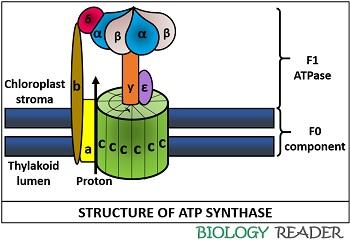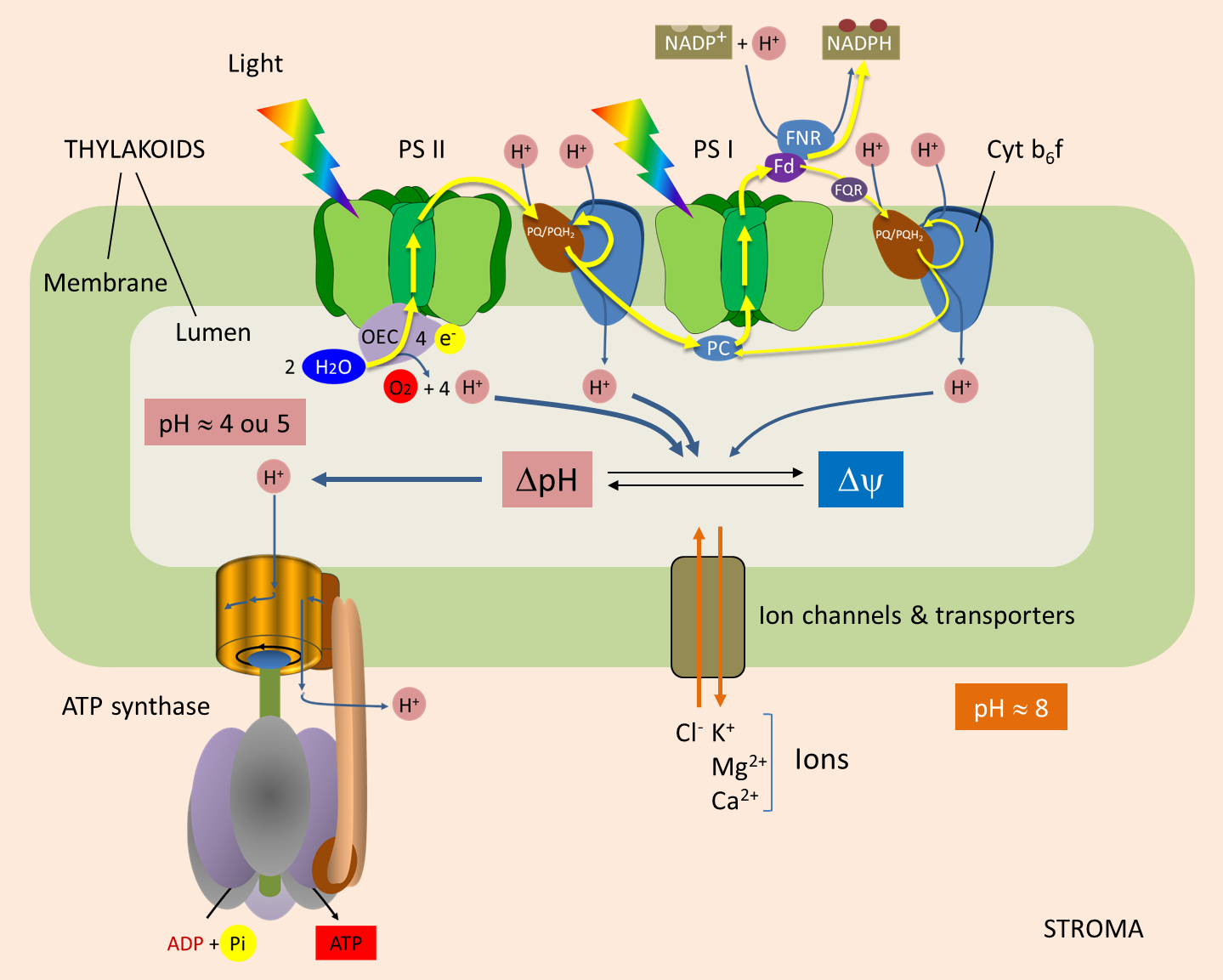Up to 24 cash back It is a hollow shape with a pathway in its center that enables protons to flow across the membrane into the mitochondrial matrix or thylakoid lumen. The function of ATP synthase is to synthesize ATP from ADP and inorganic phosphate P i in the F 1 sector.

Atp Synthase In Photosynthesis Definition Structure Mechanism Biology Reader
ATP synthase is an enzyme that can synthesize ADP and phosphate to create ATP.

. ATP synthase forms ATP from adenosine diphosphate ADP and an inorganic phosphate Pi through oxidative phosphorylation which is a process in which enzymes oxidize nutrients to form ATP. All ATP-synthase complexes producing great amounts of ATP in living organisms are coupled to chains of electron transporters integrated in membranes or in lipidprotein lamellar structures which are named transducing membranes. 1 It is the most important donor of free energy in any biological system.
ATP is synthesized through oxidative phosphorylations by an ATP-synthase complex coupled to the respiratory chain. As protons move across the membrane as facilitated by ATP synthase energy is produced. ATP synthase is an enzyme which catalyse the conversion of ADP and Pi into ATP in chloroplast and mitochondria.
A remarkable feature of the complex is the rotary movement of an assembly of subunits that plays essential roles in both transport and catalytic mechanisms. All living things use ATP. This review addresses the role of rotation in catalysis of ATP synthesishydrolysis and the transport of protons or sodium.
ATP synthase is a molecular machine. ATP synthase is a transmembrane enzyme complex which catalyses the generation of ATP through the condensation of ADP plus Pi. ATP synthase contains a membranespanning domain sometimes known as the F 0 subunit and a knobby protrusion that extends into the matrix the F 1 subunit.
The F 1 ATP synthase subunit can perform its ligase function making ATP from ADP and phosphate without proton flow. ATP synthase is a complex structure consisting of two domains F O and F 1. Chapter 10 flashcards 35 terms.
ATP synthase is an enzyme that plays a vital role in the addition of a phosphate to ADP or adenosine diphosphate to form ATP or adenosine triphosphate. This energy is used to catalyze the formation of ATP by ATP synthase hence its namesake through the. ATP synthase is an enzyme that directly generates adenosine triphosphate ATP during the process of cellular respiration.
The ATP synthase or F 1 F 0 ATPase and also referred to as complex V uses the free energy of an electrochemical gradient of protons or sodium ions generated by the respiratory chain to synthesize ATP. The mechanism of ATP synthase is not what one would naively predict. ATP synthase is a complex of several proteins shaped like a mushroom with the cap on the stromal side of the thylakoid disc and the stalk going through the thy lakoid membrane.
In eukaryotes its synthesis takes place in the mitochondria during respiration and in the chloroplasts during photosynthesis. ATP synthase kinetic mechanism rotation transport. ATP synthase is a protein that synthesizes adenosine diphosphate ADP and an extra phosphate together into adenosine triphosphate ATP.
What is the role of the proteins ATP synthase. It produce ATP witch is the very point of the respiration Through respiration there are a lot of chemical reaction called the Citric acid cycle or Krebs cyclethat use glucose and oxygen to produce ATP wich is the molecule used as energie by most organisms cells. The actions of PSII and PSI pump protons into the lumen of the thylakoid.
ATP synthase is a protein that catalyzes the formation of the energy storage molecule adenosine triphosphate ATP using adenosine diphosphate ADP and inorganic phosphate P i. Click again to see term 126 THIS SET IS OFTEN IN FOLDERS WITH. ATP is used by most all.
It is classified under ligases as it changes ADP by the formation of P-O bond phosphodiester bond. And ATP synthase provides a channel for those protons. F 1 is a spherical structure sticks out into the matrix and is anchored to the membrane consists of three α- and three β- subunits all of which can bind nucleotides but only the β-subunits can take part in the reactions Fig.
The atp synthase combine the adenosine diphosphate ADP with a phosphate molecule in order to. ATP is mainly produced in the mitochondria and is an important enzyme that provides energy for the cell to use through the synthesis of adenosine triphosphate ATP. This is possible due to energy derived from a gradient of protons which cross the inner mitochondrial membrane from the intermembrane space into the matrix through the F o portion of the enzyme.
The overall reaction catalyzed by ATP synthase is. Its primary role is to produce high energy ATP molecule. It contain 9 different sub-units.
ATP synthesis PDF ATP plays a central role in cellular metabolism. ATP synthase Click card to see definition Enzyme that synthesizes ATP. The ATP synthases comprise a very large group of highly conserved enzymes that are found in the bacterial cytoplasmic membranes the thylakoid membranes of.
The chemiosmotic model proposed a key role for a vectorial ATP synthase that would use the energy stored in a proton electrical potential for the synthesis of ATP. But as those protons travel through the ATP synthase they turn this part of it which drives this axle and then this axle nudges these parts of the protein so that they jam together an ADP with a phosphate group to produce ATP. The enzyme is located within the mitochondria of a cell where the synthesis of ATP occurs.
ATP synthase brings out the formation of ATP at the time of light-reaction photosynthesis. It is this last example that is taken here. It is located in the mitochondrial membrane for the process of cellular respiration and the thylakoid membrane for.
Adenosine triphosphate also known as ATP is a molecule that carries energy within cells. It is the main energy currency of the cell and it is an end product of the processes of photophosphorylation adding a phosphate group to a molecule using energy from light cellular respiration and fermentation. ATP synthase is an enzyme located in the mitochondria and chloroplasts plant cells that produces the energy currency of the cell known as adenosine triphosphate ATP.

Atp Synthase Definition Structure Function Video Lesson Transcript Study Com

Atp Synthesis Encyclopedia Of The Environment

Oxidative Phosphorylation Structure And Function Of Atp Synthase Mitochondrial Transport Systems And Inhibitors Of Ox Phos Bioc 460 Spring Lecture Ppt Download
0 Comments